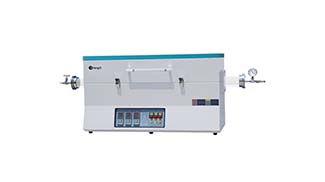The Laboratory Furnace Manufacturer shares this article for you.
1. According to the highest temperature required for the experiment, select a heating furnace with a suitable temperature range
A. When choosing the working temperature, please pay attention to the highest temperature that the instrument can maintain (<1 hour) and the temperature at which the instrument can work continuously (safe, continuous use temperature)
B. The heating element used by the instrument limits the maximum working temperature of the heating furnace
(1) 250 ~ 1250 ℃ using resistance wire heating element, the maximum heating temperature is 1200 ℃, long-term use of 1100 ℃ or infrared lamp heating element, using K-type thermocouple for temperature measurement (can also be replaced with S thermocouple if customer needs)
(2) 1300 ~ 1600 ℃ using silicon carbide heating element, using S-type thermocouple temperature measurement
(3) 1600 ~ 1800 ℃ using MoSi2 heating element (forbid to heat under 800 ℃ for a long time), using B type thermocouple for temperature measurement

2. Select the appropriate crucible and furnace tube diameter according to the sample size, and select the heating furnace with appropriate volume. (It is not recommended to directly put the sample into the furnace tube without crucible loading)
A. Crucible selection
· A. Quartz crucible: use quartz tube ≤1200℃, when the heat treatment temperature exceeds 600℃, please do not use alumina crucible
· B. Alumina crucible: use corundum tube ≤1800℃, when heat treatment temperature exceeds 900℃, please do not use mullite crucible
· C. Graphite crucible: ≤ 2300℃
1. Need to heat-treat the powder at 900℃, select the quartz crucible to load the sample
2. The alloy needs to be melted at 1600 ℃, select alumina crucible
B. Selection of pipe diameter
After selecting the crucible, select the appropriate furnace tube diameter according to the volume of the crucible after the sample is loaded (generally, the furnace will be equipped with a heating furnace tube as a standard)
· A. Quartz tube ≤1200℃ (Maximum 1000℃ under vacuum environment)
For example all kinds of samples
· B. Corundum tube ≤1800℃ (Corundum tube is not recommended for use in a vacuum environment)
3. According to the experimental requirements, choose a single-temperature zone tube heating furnace and a multi-temperature zone tube heating furnace. There will be multiple thermocouples in the multi-temperature zone compared to the single-temperature zone. The n-zone heating furnace has a constant temperature zone ratio (n-1 ) The temperature zone of the heating furnace in the temperature zone is longer, and some instruments become larger in size.
What is the role of the constant temperature zone of the tubular furnace?
(1) The role of constant temperature zone
The constant temperature zone generally refers to a zone with the same temperature in the heating furnace. When the sample is placed in this zone, the temperature received by the sample will be basically the same (the temperature difference in the center area is less than ± 1 ℃).
(2) Changes brought by different constant temperature areas
The increase or decrease of the constant temperature zone may change the size of the instrument, and the whole instrument will become larger or smaller.
(3) Selection of constant temperature area
To select a suitable constant temperature zone, you must first select according to the size of the sample or the heating volume required by the experiment.
A. The size of the experimental sample is larger than the constant temperature zone of the instrument. You need to select multiple temperature zones to increase the length of the constant temperature zone.
B. When multiple temperature gradients are required according to experimental requirements, this requires multiple temperature zones.
For example, the two-dimensional material is grown on the substrate by physical deposition. After the raw material volatilizes at high temperature, the carrier gas is used to move to the low-pressure end, and the substrate is grown on a certain temperature. (The maximum temperature difference between two adjacent temperature zones is 300℃)
Please note that the heating furnace is divided into the total heating zone length (the area covered by the heating source) and the constant temperature zone length. The constant temperature zone is always smaller than the heating zone. Please choose a furnace with a constant temperature zone larger than your sample.
4. Choose the heating furnace according to the function
A. The tube furnace is the basic heating system. You can choose a complete set of a crystalline system according to different needs, such as CVD, PECVD, HPCVD, ALD, graphene, and 2D material growth system, etc.
· For example: (1) Growth graphene/PECVD system, the whole system includes heating furnace system, radio frequency power supply, gas supply system, vacuum system, water cooling system, ventilation system, hydrogen alarm system
(2) Vertical tube furnace: the heating tube is placed vertically to provide quenching for the sample by changing the sample
(3) RTP (rapid heat treatment heating furnace): can quickly heat and cool the sample
(4) High pressure/vacuum furnace: Specially designed nickel-chromium alloy and stainless steel furnace tube, high temperature, and high pressure and vacuum treatment of samples
(5) Rotary tube furnace: The furnace tube rotary structure can heat treat the powder more uniformly, and at the same time, it can achieve the effect of uniform powder coating.
(6) Special capacity gas treatment furnace/hydrogen furnace: For hydrogen treatment or other dangerous gas experiments, please explain with the sales technician in advance. It is not recommended to use ordinary tube furnaces for dangerous experiments.
5. Choose a tube furnace with relevant certification
6. Select the appropriate vacuum pump.
评论
发表评论